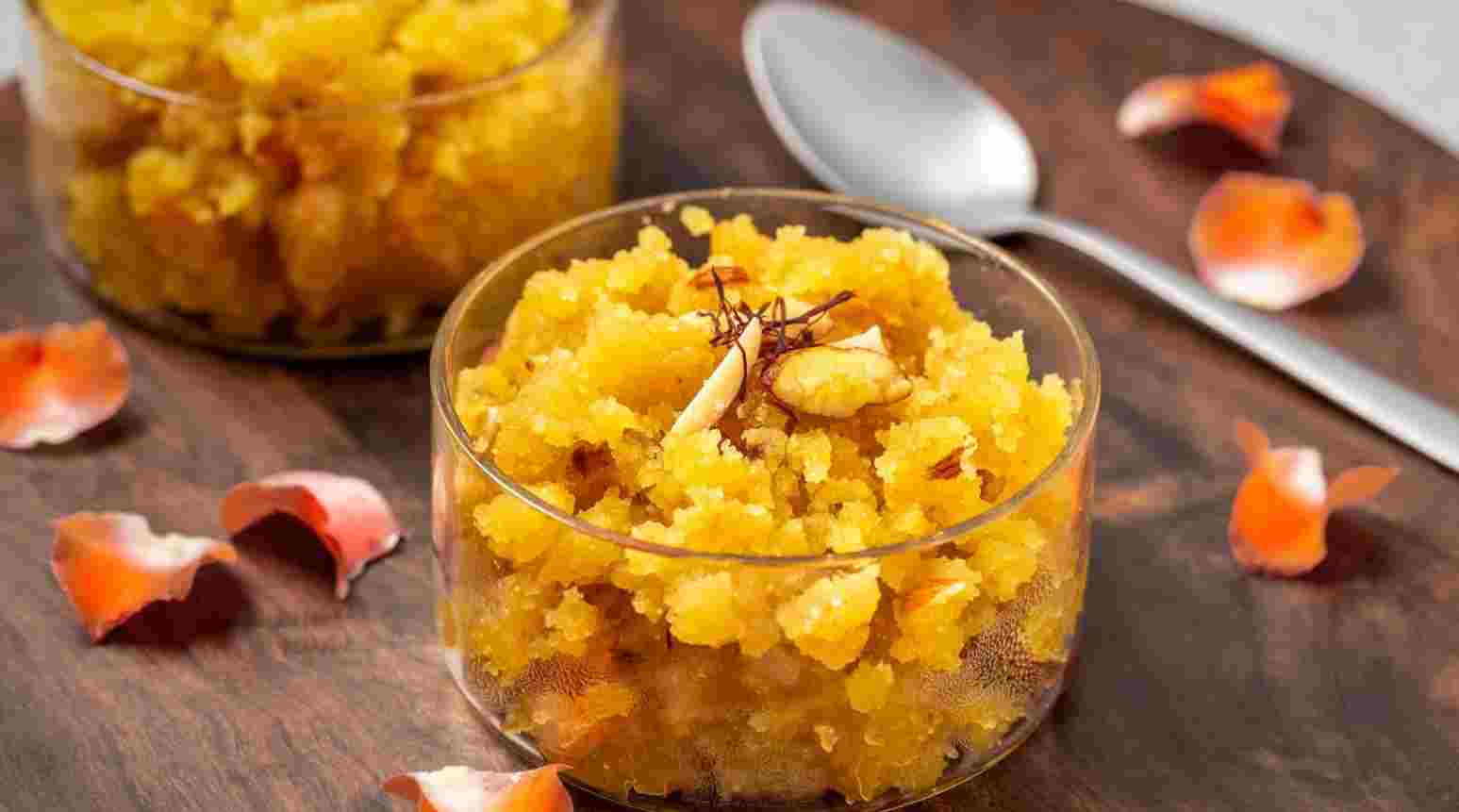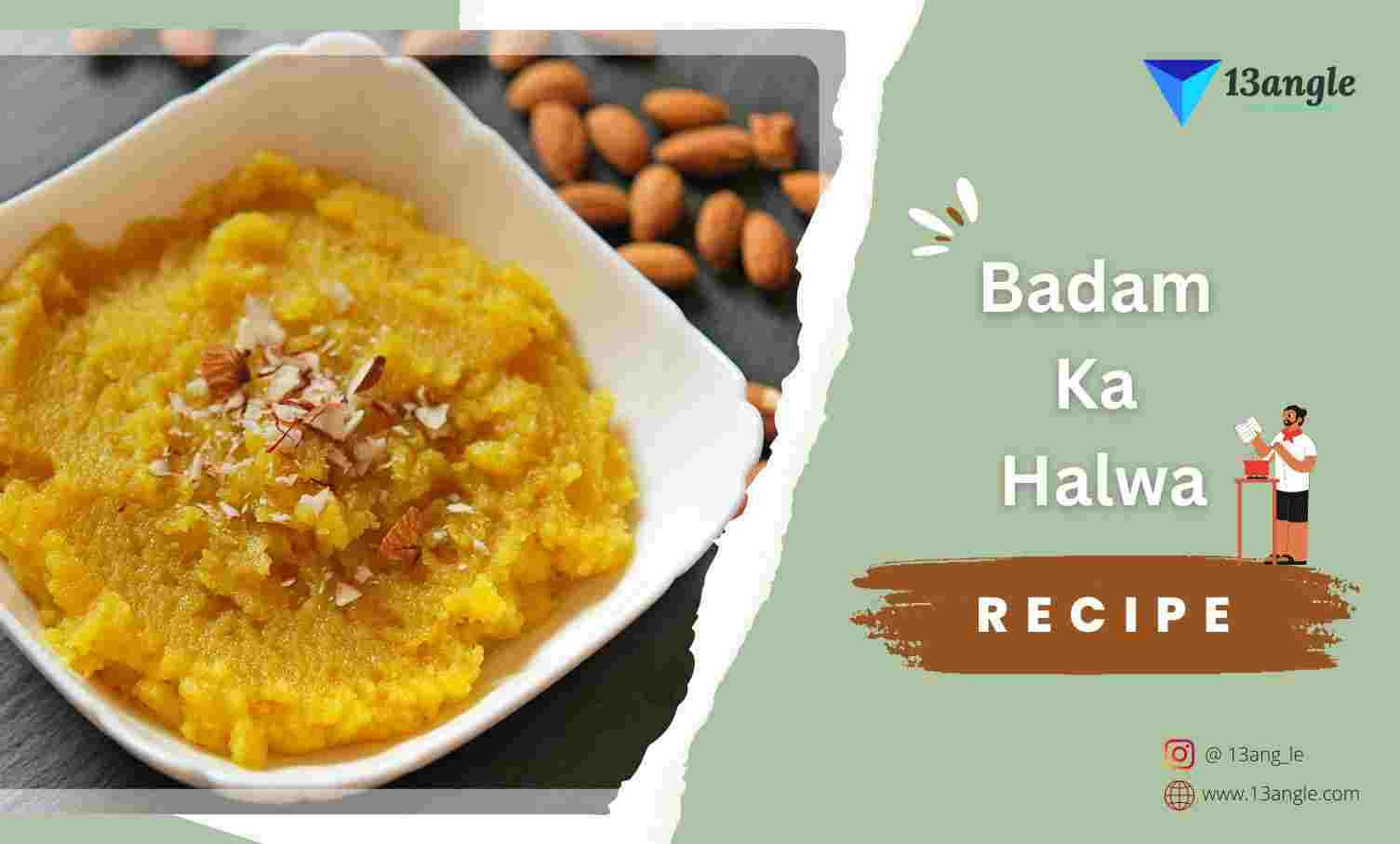- Umang Sagar
- Cuisine, Dessert & Sweets
A Symphony Of Almonds: Embracing Tradition And Indulgence In Badam Ka Halwa”

Introduction
In the heart of the culinary tapestry of India, nestled amidst the fragrant whispers of spices and the melodious sizzle of cooking pots, there exists a dessert that embodies a symphony of flavors and an ode to tradition. Badam Ka Halwa, a masterpiece of indulgence, carries with it the essence of centuries past, infused with the spirit of celebration and a touch of nostalgia.
As the almonds are transformed from their humble state to a velvety elixir, every spoonful of Badam Ka Halwa is a rendezvous with indulgence. The nutty aroma envelops the senses, invoking memories of family gatherings and joyful festivities. With a texture that dances between silkiness and a delightful graininess, each bite is an exploration of culinary craftsmanship.
This halwa is not just a dessert; it is a treasure trove of emotions, carefully handed down through generations, and a testament to the artistry that resides within every Indian kitchen. It represents the bonds forged over shared meals and the stories exchanged as loved ones gather around to savour its splendour.
Badam Ka Halwa stands as a testament to the creativity and passion that infuse Indian cooking, transforming humble ingredients into culinary magic. With each luscious mouthful, it whispers tales of resilience and dedication, inspiring us to create and celebrate the rich heritage that lives within every delectable bite.
History And origin

The history and origin of Badam Ka Halwa, or Almond Halwa, can be traced back to the rich culinary traditions of the Indian subcontinent. While the exact historical details may be challenging to pinpoint, the dish has evolved over centuries because of cultural influences and culinary creativity.
Almonds have been a cherished ingredient in Indian cuisine for a long time, valued for their nutritional benefits and versatility. The preparation of almond-based sweets and desserts has been a part of Indian culinary practices for centuries.
The origins of Badam Ka Halwa are rooted in the broader context of Indian sweets and desserts, which have a significant place in the country’s cultural and religious traditions. Sweets made from nuts, such as almonds, were often prepared for festive occasions, celebrations, and special gatherings.
It is likely that Badam Ka Halwa, like many other traditional Indian sweets, evolved because of the interaction of different communities, trade routes, and cultural exchanges. As almonds were introduced to the Indian subcontinent and became more widely available, they found their way into various culinary creations, including halwa.
Over time, Badam Ka Halwa gained popularity and recognition as a rich and luxurious dessert that showcased the natural richness of almonds, the aromatic touch of cardamom, and the indulgence of ghee and sugar.
While the precise timeline of the dish’s emergence is not documented, Badam Ka Halwa has become a beloved and timeless treat that is enjoyed across regions, communities, and generations. It’s a testament to the enduring appeal of traditional Indian sweets and the art of using simple ingredients to create exquisite culinary experiences.
Recipe

Badam Ka Halwa, or Almond Halwa, is a rich and decadent Indian dessert made from almonds, ghee, sugar, and saffron. It’s a delightful treat often prepared during festivals, celebrations, or special occasions. The process of making Badam Ka Halwa involves grinding almonds into a fine paste and then cooking it with ghee and sugar to create a luxurious and aromatic dessert.
Ingredients:
- 1 cup almonds
- 1/2 cup ghee (clarified butter)
- 1 cup sugar (adjust to taste)
- 1/2 teaspoon cardamom powder
- A pinch of saffron strands
- Chopped almonds and pistachios for garnishing
- Silver or gold leaf (optional, for garnishing)
Instructions:
- Preparing the Almonds:
- Soak the almonds in hot water for about 2 hours or until the skins become loose.
- Drain the almonds and rinse them with cold water.
- Gently press each almond between your fingers to remove the skin. The skin should easily peel off.
- Blanching and Grinding:
- Place the blanched almonds in a food processor or blender.
- Grind the almonds into a smooth paste. You can add a little milk or water to facilitate the grinding process.
- Infusing Saffron:
- In a small bowl, soak a pinch of saffron strands in a tablespoon of warm milk. Let it sit for a few minutes to release its colour and aroma.
- Cooking the Almond Paste:
- In a heavy-bottomed pan or kadai, heat the ghee over medium heat.
- Add the almond paste and sauté it in the ghee, stirring constantly. Cook for about 15-20 minutes until the almond paste turns a light golden colour and releases a nutty aroma.
- Adding Sugar and Saffron:
- Add the sugar to the almond mixture and mix well. The sugar will melt and combine with the almond paste.
- Stir in the saffron-infused milk and mix until the saffron is evenly distributed.
- Cooking to Desired Consistency:
- Continue cooking the mixture over medium heat, stirring frequently, until it thickens and leaves the sides of the pan. This might take another 15-20 minutes.
- Flavoring and Garnishing:
- Stir in the cardamom powder, which adds a delightful aroma and flavour to the halwa.
- Once the halwa reaches the desired consistency, turn off the heat.
- Garnish with chopped almonds and pistachios. You can also add a touch of silver or gold leaf for an elegant touch (optional).
- Serving:
- Serve Badam Ka Halwa warm or at room temperature.
- It can be enjoyed on its own or with a scoop of vanilla ice cream for a delightful contrast of flavours and temperatures.
Enjoy the luxurious and nutty goodness of Badam Ka Halwa, a classic Indian dessert that’s sure to impress your taste buds and leave you craving more!
Top 13 Interesting Facts
Nutritional Delight: Badam Ka Halwa is not only delicious but also nutritious, as almonds are a rich source of healthy fats, protein, fibre, and essential nutrients like vitamin E and magnesium.
Culinary Heritage: The dish is deeply rooted in the culinary traditions of the Indian subcontinent, where almonds have been valued for their taste and health benefits for centuries.
Variations: While almonds are the primary ingredient, variations of Badam Ka Halwa may include the addition of milk, khoya (reduced milk solids), or even saffron to enhance flavour and texture.
Festive Delight: Badam Ka Halwa is often prepared during festivals, weddings, and special occasions, making it a cherished part of celebratory feasts.
Mughal Influence: The Mughal period in India (16th to 19th centuries) played a significant role in the evolution of Indian sweets, and it’s likely that the use of almonds in halwa was influenced by Mughal culinary practices.
Luxurious Flavour: The combination of ground almonds, ghee, and sugar results in a luxurious and rich flavour profile that’s both indulgent and satisfying.
Aromatic Essence: Cardamom is a key spice used in Badam Ka Halwa, contributing to its aromatic and captivating fragrance.
Art of Preparation: Making Badam Ka Halwa requires patience and attention, as the almonds need to be blanched, peeled, and ground into a paste before being cooked to the desired consistency.
Texture Matters: Achieving the right texture is crucial, with the halwa being cooked until it reaches a smooth, luscious, and slightly grainy consistency.
Garnishing: The halwa is often garnished with chopped almonds and sometimes even adorned with silver or gold leaf, adding to its visual appeal.
Regional Variations: While Badam Ka Halwa is enjoyed across India, different regions may have their own unique interpretations and variations of the dish.
Modern Twists: Contemporary chefs and home cooks often experiment with Badam Ka Halwa, incorporating innovative flavours like rose, saffron, or even chocolate to create modern renditions.
Cultural Symbolism: Badam Ka Halwa embodies the celebration of flavours, tradition, and the joy of sharing special moments with loved ones.
FAQs
To make Badam Ka Halwa, follow these steps:
- Blanch and peel almonds, then grind them into a smooth paste.
- Heat ghee in a pan and sauté the almond paste until it turns golden and releases a rich aroma.
- Add sugar, cardamom powder, and saffron-infused milk. Continue cooking until the mixture thickens.
- Garnish with chopped nuts and serve warm or at room temperature.
The main ingredients for Badam Ka Halwa include blanched almonds, ghee, sugar, cardamom powder, saffron, and chopped nuts for garnishing.
Yes, Badam Ka Halwa is naturally gluten-free, as it does not contain wheat or gluten-based ingredients.
While using whole almonds is traditional, you can use almond flour to make the process quicker. However, grinding whole almonds provides a fresher flavour and texture.
Serve Badam Ka Halwa warm or at room temperature. It can be enjoyed on its own as a dessert or paired with a scoop of ice cream for added indulgence.
Yes, you can store Badam Ka Halwa in an airtight container in the refrigerator for a few days. Reheat it before serving.
Yes, saffron is optional and can be omitted if you prefer. It adds colour and aroma but is not essential to the dish.
Yes, you can make a vegan version by substituting ghee with plant-based butter or oil and using non-dairy milk for saffron infusion.
Badam Ka Halwa is unique due to its primary ingredient – almonds. While other halwa might use ingredients like wheat, lentils, or fruits, Badam Ka Halwa showcases the rich and nutty flavour of almonds.
Yes, you can scale up the recipe to make larger quantities. Just ensure you have a larger pan to accommodate the increased ingredients.
Yes, you can use jaggery to make a variation of Badam Ka Halwa. Dissolve grated jaggery in water and use it as a sweetener.
While cardamom is traditional, you can experiment with other flavourings like rose water, kesar (saffron), or even a pinch of nutmeg.
Badam Ka Halwa is often prepared and enjoyed during festivals, celebrations, weddings, and special occasions in Indian culture.
Enjoy the sumptuous flavours of Badam Ka Halwa, a delightful dessert that captures the essence of almonds and aromatic spices!



